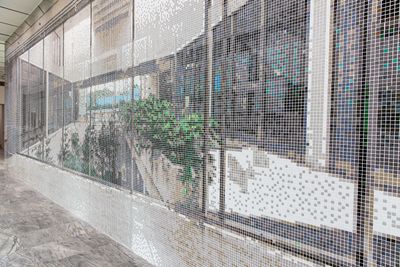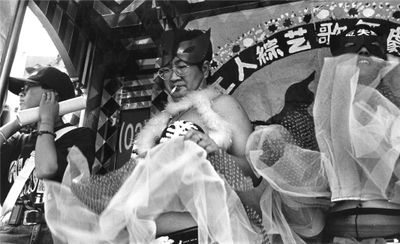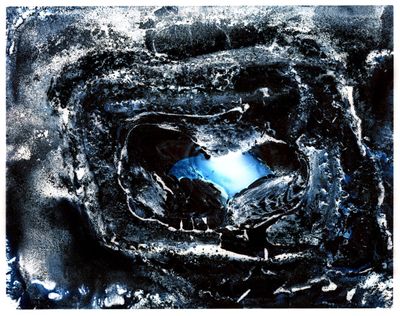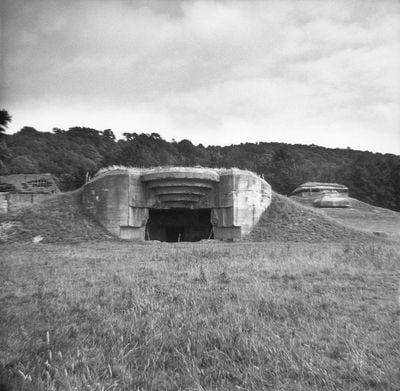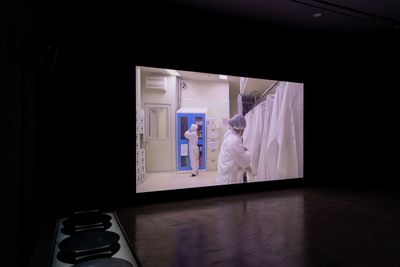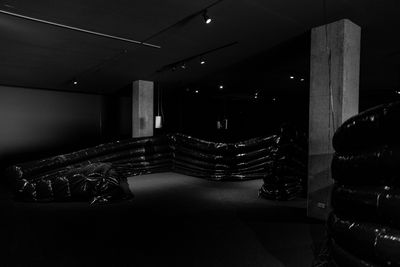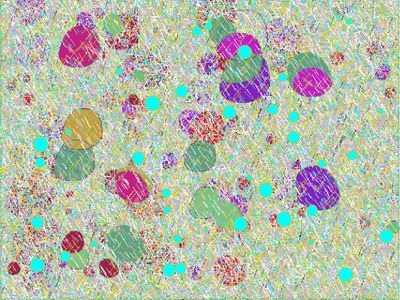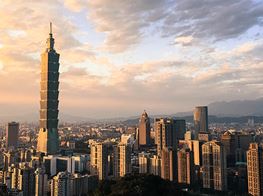Taipei Biennial Celebrates a World Worth Fighting For
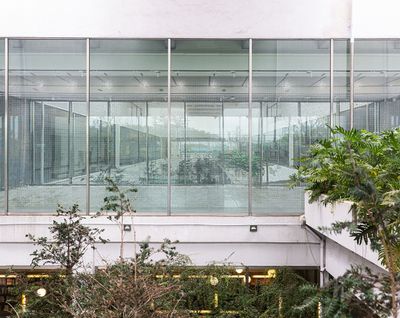
Wang Wei, Mirror (2023). Mosaic tiles. 1600 x 400 x 30 cm. Exhibition view: Taipei Biennial: Small World, Taipei Fine Arts Museum (18 November 2023–24 March 2024). Courtesy the artist and TFAM.
Ahead of the entrance to the ground floor galleries of the Taipei Fine Arts Museum, is an apt introduction to Small World, the 13th Taipei Biennial curated by Freya Chou, Reem Shadid, and Brian Kuan Wood.
Wang Wei's Mirror (2023) is a standing mosaic wall depicting a mirror image of the site it faces: a window-lined void framing a view of the museum's courtyard garden below. Sourced from Fosan in Guangdong, the tiles Wang used were commonly used in buildings constructed in the 1970s and 1980s in Taiwan, Hong Kong, and southern China.
Each individual tile, then, creates a material point of connection spanning geographies, which expands well beyond the site-specific representation they compose. That movement defines the exhibition's curatorial theme, which considers a paradoxical world of increasing connection and division. Such that a tile, much like a pixel in a digital image, can expand and contract in both meaning and context in an instant.
Take the first-floor gallery, which opens with Arthur Ou's Untitled (Octavia with Meteor 1) (2020): a photograph of a triangular piece of meteoric debris balancing on a fingertip. From here, Hsu Tsun-Hsu's black-and-white photographic series charting Taiwan's transition to democracy line a green wall ('The More We Get Together', 1988–1998).
Behind this wall, in a separate room, is Lara Tabet's Eleven Fragmented Seas (2020). What appear to be close-up views of swirling waters or rocky surfaces were in fact created by incubating bacteria drawn from the Lebanese coastline on analogue colour film, before the results were scanned and printed.
Further along this section of the show, are black-and-white studio photographs from Arthur Ou's 'Viewfinder' series (2020–ongoing), capturing children looking upwards through binoculars. Presented alongside another Untitled (Octavia with Meteor) print, the 'Viewfinder' images connect the act of looking with an imaginative projection, such that the universe might be glimpsed metaphorically through a tiny cosmic fragment.
Oscillations of scale and meaning continue in the second ground-floor gallery. Here, black-and-white photographs of abandoned German World War II bunkers along the French coast from Paul Virilio's 'Bunker Archaeology' series (1958–1965), overlook Nadim Abbas' Pilgrim in the Microworld (2023), a large-scale installation taking over the centre of the room.
Galvanised-steel containers holding brutalist sand-structures bordered by radioactive-green water are placed atop a network of silver vinyl lines. The overall effect is the visualisation of a giant circuit board.
Takashi Ito's short film Spacy (1981) extends the movement of scales defining Abbas' installation and Small World as a whole. In a small room, four screens positioned at cardinal points continuously play the same stop-motion sequence of 700 16 mm photographs, separated by a short time delay. The images depict the inside of a gymnasium, where photographs of the same interior presented on several easels act like a portal into what feels like an eternal loop revolving around the space and its representation.
That movement defines the exhibition's curatorial theme, which considers a paradoxical world of increasing connection and division.
The effect of Spacy is not unlike Wang Wei's mosaic Mirror, which is viewed from the other side of the building's courtyard void through another line of windows from the exit of this particular gallery. On this side of the museum, a giant image of a bunker from Virilio's 'Bunker Archaeology' series is pasted onto a wall, just ahead of a corridor where a long vitrine presents the 32 screenprints comprising Seher Shah's Notes from a City Unknown (2021).
Created between 2014 and 2021 when Shah lived in New Delhi, pages of architectural-style blocks are accompanied by poetic titles and reflections. These include 'City of Testimonies' which notes 'the weight of her failed nations'; 'City of 1947', referring to the year of India's partition; and 'Destiny blinded by artificial light and real estate'.
Shah's installation heralds the tonal shift on the second floor, which opens with a single print from Virilio's Bunker series. The photo is hung on a single wall that acts like a gateway into a section of Small World that leans into postwar political themes bearing down on the present.
Hybridising the style of Persian miniature paintings with the classic blue-on-white aesthetic of Ming porcelain, the images painted onto the seven vases composing Raed Yassin's China (2012) present battles from Lebanon's civil war (1975–1990), including the Israeli invasion of southern Lebanon.
While Su Yu-Hsin's film installation Particular Waters (2023), follows a water truck driver servicing the water-intensive production of semiconductors by the Taiwan Semiconductor Manufacturing Company, whose importance in the global market translates into a geopolitical bargaining chip for Taiwan—a faultline in the old-new Cold War. Water shortages and climate change aside.
The growing chokehold that industry has on all aspects of life is expanded in Jen Liu's The Land at the Bottom of the Sea (2023), which departs from the stories of Chinese women labour activists who have disappeared. Through 3D animation and live-action sequences, Liu tells the story of a phone-addicted worker who is eaten by carnivorous mermaids. She visualises a world where everyone has become liquidated into commercial data, such that a body and a server pod at the bottom of the sea are viewed as the same thing: grist for the mill.
Jacqueline Kiyomi Gork's installation's Not Exactly (Whatever the New Key Is) (2017–ongoing) seems to carry the unbearable weight of that reality. Within a black room, an inflatable black maze inflates and collapses in time with melodic acapella chants coming from six dispersed speakers, expressing sounds evocative of an emotive, dream-pop lament.
Gork's invitation to wander through space while feeling out its affective, sensory contours resonates with Natascha Sadr Haghighian's sound installation Watershed (2023), installed in the museum's internal basement courtyard garden.
Six multi-limbed, multi-headed figures created from a mash-up of pearlescent, clear plastic templates for woodland animals each perch on a walking frame around the foliage. Within each form is a sound-conducting transducer emitting ambient sounds drawn from the vicinity, interacting with a modular synthesiser patch by artist James T. Hong, and voices singing lyrics based on Karen Mok's turn-of-the-millennium ballad 'Suddenly' in Chinese, Cantonese, English, and Minan.
An irregular and contingent rhythm keeps Watershed from collapsing into a sense of formal completion, thanks to the noises blending into its composition in real time—whether the rustle of ground stones or the roar of planes flying low overhead to and from the nearby airport—and the vulnerability of each sculpture, where some plastic joints remain unconnected or have come apart.
As the artist has noted, Watershed is dedicated to caretakers—a point that resonates with Small World as an exhibition that is sensitive to the intimate and precarious contours of an emergent 21st century. Because what defines a caretaker more than vigilance to precarity?
With that in mind, it makes sense that Watershed is presented on the same level as the Biennial's Music Room, which hosted a group performance honouring turntablism as a practice of collective listening and improvisation in December with Mariam Rezaei, SlowPitchSound, DJ Rex Chen, and dj sniff.
A work by dj sniff, Transformer (2023), is also presented in the exhibition. Deconstructed turntable machinery, positioned on and over a low platform, honours Grandmaster Flash's pioneering contributions to turntablism. A soundscape defined by the sounds of a Technics 1200 MK2's inner circuitry is played through a modified Flash Former, which Grandmaster Flash designed in 1988.
The attention Small World gives to turntablism highlights the harmonisation of the exhibition's many parts by its three curators. Tying it all together are computer-based kinetic paintings by Samia Halaby, which appear throughout the show. Originating in the mid-1980s, these particular works come from a 2019 performance by the Kinetic Painting Group, where Halaby collaborates with artists and musicians to perform paintings in public with live sound.
One such performance with Julian Abraham 'Togar' took place during Small World's opening events, with Halaby creating a live painting on-screen to sounds of percussion, singing, and chanting, including those calling for a free Palestine. All of which highlights what is at stake in this biennial, which holds ground for creativity as a responsive, vigilant force of connection and solidarity. A 'small world' worth fighting for. —[O]

